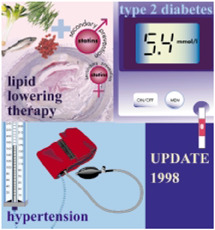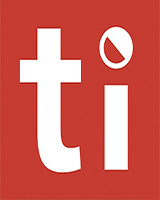This is an open-access article distributed under the terms of the Creative Commons Attribution License, which permits unrestricted use, distribution, and reproduction in any medium, provided the original work is properly cited.
NCBI Bookshelf. A service of the National Library of Medicine, National Institutes of Health.
Perry T, editor. Therapeutics Letter. Vancouver (BC): Therapeutics Initiative; 1994-.
Therapeutics Letter 27 summarizes the findings of six randomized controlled trials (RCTs) and synthesizes the evidence from these trials in the context of previous letters relating to treatment of hypertension (Letters 7, 8, 9, 16), Type 2 diabetes (Letter 23), Lipid lowering therapy (Letter 24), and olanzapine (Letter 20).
Keywords:
Antihypertensive Agents; Cholesterol; Diabetes Mellitus, Type 2; Hydroxymethylglutaryl-CoA Reductase Inhibitors; Hypertension; Metformin; Olanzapine; Thiazides
Treatment of Hypertension
The SYST-EUR trial1 compared active treatment with placebo in older patients with isolated systolic hypertension. A dihydropyridine calcium channel blocker (CCB), nitrendipine, was first-line treatment (enalapril, hydrochlorothiazide or both were second and third line drugs). These results can be compared to the SHEP trial, where chlorthalidone was first-line therapy.
| Total CV events | ARR % | NNT | Dur. yrs | ||
|---|---|---|---|---|---|
| control% | treatment % | ||||
| SYST-EUR | 8.1 | 5.7 | 2.4 | 42 | 2.1 |
| SHEP | 18.4 | 12.0 | 6.4 | 16 | 4.5 |
ARR = absolute risk reduction
NNT = number needed to treat to prevent one event
The Hypertension Optimal Treatment (HOT) trial2 had 2 objectives: 18,790 patients with hypertension were randomly assigned to one of 3 target diastolic pressures, ≤90 mm Hg, ≤85 mm Hg, or ≤80 mm Hg, and to 75 mg/day acetylsalicylic acid or placebo. There was no placebo group so overall effectiveness could not be determined. Step therapy was predefined: 1: felodipine 5 mg/day, 2: ACE inhibitor or beta blocker, 3: 10 mg felodipine, 4: double dose step 2 drug, and 5: thiazide. A 2 mm Hg difference in systolic and diastolic blood pressure was attained between each of the 3 target groups. The 2 groups with lower BP might be expected to have fewer cardiovascular events, but this was not seen; the primary outcome measure, major cardiovascular events, was similar for the 3 groups, 3.7%, ≤90 mm Hg, 3.7%, ≤85 mm Hg, and 3.5%, ≤80 mm Hg. Subgroup analysis of the 8% of patients with Type 2 diabetes at baseline did show total cardiovascular events lower in the ≤80 mm Hg group, 4.4%, than the ≤90 mm Hg group, 9.0%, ARR = 4.6%, NNT = 22 for 3 yrs. In the non-diabetic patients (92% of population) there was a trend towards an increased mortality with a greater intensity of treatment (2.7% ≤90 mm Hg, 2.9% ≤85 mm Hg, 3.3% ≤80 mm Hg, p= 0.07). The incidence of side effects at 24 months was not statistically different between the 3 target groups. Aiming for a target diastolic BP of lower than 90 mm Hg provides no therapeutic advantage for most hypertensive patients.
A small statistically significant decrease in total cardiovascular events was seen with ASA (3.3%) as compared to placebo (3.9%), ARR = 0.6%, NNT = 175 for 3.8 yrs. This difference became non-significant when silent myocardial infarctions were included as an event. ASA therapy was associated with an increased risk of non-fatal major and minor bleeds (3.0% v 1.6%) absolute risk increase (ARI) = 1.4%, number needed to treat to harm one patient (NNH) = 74 for 3.8 yrs. Benefits of ASA do not exceed risks in an unselected group of hypertensive patients.
Treatment of Type 2 Diabetes
The UK Prospective Diabetes Study (UKPDS)3–6 randomised newly diagnosed Type 2 diabetics (N = 3867) to conventional therapy or intensive therapy with sulfonylureas (chlorpropamide, glyburide) or insulin3. Conventional therapy included drug treatment only if fasting blood glucose was >15mmol/L or symptoms of hyperglycemia developed. Intensive treatment with sulfonylureas or insulin reduced HbA1C to 7.0 % as compared to 7.9% over the 10 years of the study. The primary outcome, any of 21 diabetes related endpoints, was significantly reduced by intensive treatment, 35.3% v 38.5%, ARR = 3.2%, NNT = 31 for 10 yrs.
This difference was predominantly due to reduction in the microvascular complication, retinopathy requiring photocoagulation. Cardiovascular events were not significantly reduced; there was a trend towards reduction in total MI, 14.2% v 16.3%, p=0.052. There were no significant differences in outcome between the different sulfonylureas or insulin. Over the first 10 years intensive therapy increased major hypoglycemic episodes: conventional therapy, 1%, chlorpropamide, 4%, glyburide, 6%, and insulin, 23%. Intensive therapy also caused greater weight gain than conventional therapy: insulin, 4.0 kg, chlorpropamide, 2.6 kg and glyburide, 1.7 kg.
In the same trial 1704 overweight diabetic patients were randomised to metformin, conventional therapy or intensive treatment with sulfonylureas or insulin. Incidence of any diabetes endpoint was significantly reduced by metformin, 28.7% (ARR = 10.2%, NNT = 9 for 10.7 yrs) as compared to conventional, 38.9%, or intensive, 36.8%, therapy. Diabetes related deaths, total mortality and total myocardial infarctions were also significantly reduced by metformin4. Metformin caused no increase in major hypoglycemic episodes and no weight gain as compared to conventional therapy. In a separate RCT when patients on maximal sulfonylurea therapy were randomised to added metformin or placebo no benefit was seen from adding metformin over a 6.6 year period. For first-line Type 2 diabetes therapy the benefit/risk ratio for metformin is many fold greater than that for sulfonylureas or insulin.
In the same trial 1148 patients with hypertension were randomly allocated to tight blood pressure control or to less tight control5. The tight control group was randomized to captopril or atenolol; the second-line drug was furosemide. ACE inhibitors and beta blockers were not used in the less tight control group. The mean blood pressure for tight control was 144/82 mm Hg as compared to 154/87 mm Hg. Tight control resulted in a significant reduction in any diabetes endpoint, 34.1% v 43.5%, ARR = 9.4%, NNT = 11 for 8.4 yrs. Diabetes related death, stroke, and microvascular disease were also significantly reduced. There were no significant differences between captopril and atenolol in blood pressure reduction or any outcome parameter, including progression of albuminuria6.
The benefits achieved from intensive blood pressure reduction in Type 2 diabetes are of similar magnitude to those achieved with metformin.
Lipid lowering therapy
The AFCAPS7 and LIPID8 trial add to our outcome data with statins. All trials were for approximately 5 years; women were under-represented, <15% overall. The chances that a patient will benefit from treatment with a statin becomes very small as the risk (event incidence in control group) decreases.
Olanzapine
The full 28-week trial comparing olanzapine (17.2 mg/day) with risperidone (7.2 mg/day) showed fewer extrapyramidal side effects with olanzapine (18.6% v 31.1%) and greater weight gain with olanzapine (4.1 kg v 2.3 kg)9. Details of the previously noted cases of leukopenia with olanzapine have now been published; in all 3 cases olanzapine was associated with an accentuation and prolongation of granulocytopenia in patients who had not fully recovered from clozapine-induced granulocytopenia10. The risk of granulocytopenia with olanzapine appears to be similar to other antipsychotics like haloperidol and risperidone.
References
- 1.
- Staessen JA, Fagard R, Thijs L, et al. Randomised double-blind comparison of placebo and active treatment for older patients with isolated systolic hypertension .Lancet 1997;350:757–764. [PubMed: 9297994]
- 2.
- Hansson, L, Zanchetti, Carruthers SG, et al. Effects of intensive blood-pressure lowering and low-dose aspirin in patients with hypertension: principal results of the hypertension optimal treatment (HOT) randomised trial. Lancet 1998;351:1755–62. [PubMed: 9635947]
- 3.
- UKPDS Group. Intensive blood-glucose control with sulphonylureas or insulin compared with conventional treatment and risk of complications in patients with type 2 diabetes (UKPDS 33) .Lancet 1998;352:837–53. [PubMed: 9742976]
- 4.
- UKPDS Group. Effect of intensive blood-glucose control with metformin on complications in overweight patients with type 2 diabetes (UKPDS 34) .Lancet 1998;352:854–65. [PubMed: 9742977]
- 5.
- UKPDS Group. Tight blood pressure control and risk of macrovascular and microvascular complications in type 2 diabetes (UKPDS 38) .Brit Med J. 1998;317:703–713. [PMC free article: PMC28659] [PubMed: 9732337]
- 6.
- UKPDS Group. Efficacy of atenolol and captopril in reducing risk of macrovascular and microvascular complications in type 2 diabetes (UKPDS 39) .Brit Med J. 1998;317:713–720. [PMC free article: PMC28660] [PubMed: 9732338]
- 7.
- Downs JR, Clearfield M, Wais S, et al. Primary prevention of acute coronary events with lovastatin in men and women with average cholesterol levels. Results of AFCAPS/TexCAPS .JAMA 1998;279:1615–1622. [PubMed: 9613910]
- 8.
- The LIPID Study Group. Prevention of cardiovascular events and death with pravastatin in patients with coronary heart disease and a broad range of initial cholesterol levels .N Engl J Med 1998;339:1349–57. [PubMed: 9841303]
- 9.
- Tran PV, Hamiliton SH, Kuntz Am, et al. Double-blind comparison of olanzapine versus risperidone in the treatment of schizophrenia and other psychotic disorders .J Clin Psychiatry 1997;58:250–211. [PubMed: 9315992]
- 10.
- Flynn SW, Altman S, MacEwan GW, et al. Prolongation of clozapine-induced granulocytopenia associated with olanzapine .J Clin Psychopharmacol 1997;17:494–5. [PubMed: 9408818]
Footnotes
This Letter contains an assessment and synthesis of published (and whenever possible peer-reviewed) publications up to Dec. 1, 1998. We attempt to maintain the accuracy of the information in the Therapeutics Letter by extensive literature searches and verification by both the authors and the editorial board. In addition this Therapeutics Letter was submitted for review to 54 experts and primary care physicians in order to correct any identified shortcomings or inaccuracies and to ensure that the information is concise and relevant to clinicians.
- The Therapeutics Initiative’s objectives are unbiased review and dissemination of therapeutic evidence. Our recommendations are intended to apply to most patients; exceptional patients require exceptional approaches. We are committed to evaluate the effectiveness of our educational activities using the Pharmacare/Pharmanet database without identifying individual physicians, pharmacists or patients. Please notify us if you do not wish to be part of this evaluation. The Therapeutics Initiative is funded through a 5-year grant to the University of British Columbia from the Government of British Columbia, Ministry of Health and Ministry Responsible for Seniors.
- Review Blood pressure-lowering efficacy of monotherapy with thiazide diuretics for primary hypertension.[Cochrane Database Syst Rev. 2014]Review Blood pressure-lowering efficacy of monotherapy with thiazide diuretics for primary hypertension.Musini VM, Nazer M, Bassett K, Wright JM. Cochrane Database Syst Rev. 2014 May 29; 2014(5):CD003824. Epub 2014 May 29.
- First-line drugs inhibiting the renin angiotensin system versus other first-line antihypertensive drug classes for hypertension.[Cochrane Database Syst Rev. 2018]First-line drugs inhibiting the renin angiotensin system versus other first-line antihypertensive drug classes for hypertension.Chen YJ, Li LJ, Tang WL, Song JY, Qiu R, Li Q, Xue H, Wright JM. Cochrane Database Syst Rev. 2018 Nov 14; 11(11):CD008170. Epub 2018 Nov 14.
- Review First-line drugs for hypertension.[Cochrane Database Syst Rev. 2018]Review First-line drugs for hypertension.Wright JM, Musini VM, Gill R. Cochrane Database Syst Rev. 2018 Apr 18; 4(4):CD001841. Epub 2018 Apr 18.
- Review First-line diuretics versus other classes of antihypertensive drugs for hypertension.[Cochrane Database Syst Rev. 2023]Review First-line diuretics versus other classes of antihypertensive drugs for hypertension.Reinhart M, Puil L, Salzwedel DM, Wright JM. Cochrane Database Syst Rev. 2023 Jul 13; 7(7):CD008161. Epub 2023 Jul 13.
- Blood pressure-lowering activity of statins: a systematic literature review and meta-analysis of placebo-randomized controlled trials.[Eur J Clin Pharmacol. 2020]Blood pressure-lowering activity of statins: a systematic literature review and meta-analysis of placebo-randomized controlled trials.Alghamdi J, Alqadi A, Alharf A, Almuzzaini B, Mahmud A, Barhoumi T, Badreldin HA, Alaamery M, Padmanabhan S. Eur J Clin Pharmacol. 2020 Dec; 76(12):1745-1754. Epub 2020 Jul 21.
- Review & Update 1998 - Therapeutics LetterReview & Update 1998 - Therapeutics Letter
Your browsing activity is empty.
Activity recording is turned off.
See more...
